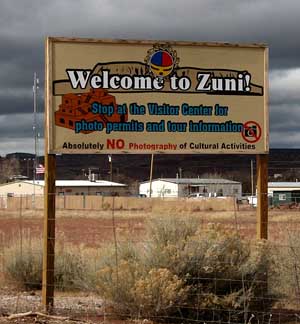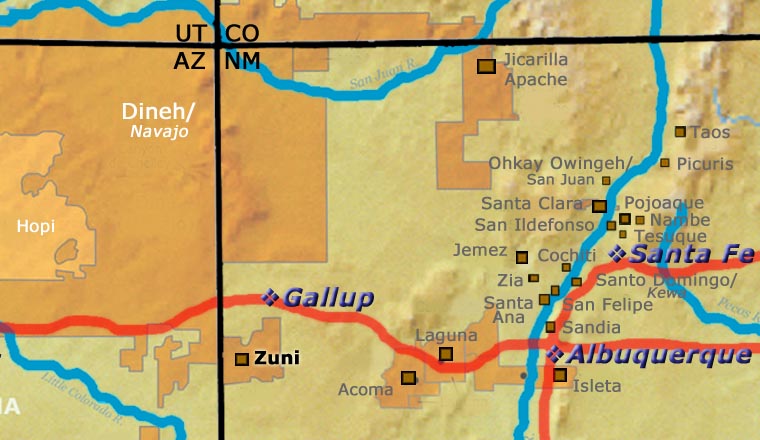
Gabriel Paloma
Zuni

Gabriel Paloma was born to Herman and Janice Paloma of Zuni Pueblo in September 1966. When he attended Zuni High School, he took the ceramics class offered by Jennie Laate and was enthralled.
He continued taking ceramics classes when he attended the University of New Mexico in Albuquerque and at the UNM satellite campus in Gallup. Then he worked with Eileen Yatsattie in the Zuni Creative Arts Program. When Noreen Simplicio stepped back from teaching the pottery classes at Zuni High School after Jennie Laate died, Gabriel took over.
Gabriel has continued making pottery and entering it in juried competitions. He's earned prize ribbons at the Gallup InterTribal Ceremonials and at the Museum of Northern Arizona Zuni Show, including a prestigious Curator's Award.
Gabriel's work can be seen at the Museum of Northern Arizona, the Cincinnati Museum of Art, the Houston Museum of Natural Sciences and others. He primarily makes polychrome jars, cornmeal bowls and cups, decorating them tadpoles, water serpents, dragonflies, spirals, terraced clouds and rain symbols. He also makes watercolors, acrylic paintings and mixed media, and carves kachinas.
Some Awards Gabriel has Won
- 2024 Santa Fe Indian Market, Classification IIE: Category 907 - Painted, any form, First Place
- 2019 Santa Fe Indian Market, Classification II - Pottery, Division E - Contemporary pottery, any form or design, using commercial clays/glazes, all firing techniques: Best of Division
- 2019 Santa Fe Indian Market, Classification II - Pottery, Division E - Contemporary pottery, any form or design, using commercial clays/glazes, all firing techniques, Category 907 - Painted, any form: First Place
- 2015 Heard Museum Guild Indian Fair & Market, Classification II - Pottery, Division A - Traditional - native clay, hand built, painted: Honorable Mention
- 2004 Santa Fe Indian Market, Classification II - Pottery, Division G - Non-traditional pottery, using traditional materials and techniques, any form or design, Category 1401 - Jars, wedding jars: Second Place
100 West San Francisco Street, Santa Fe, New Mexico 87501
(505) 986-1234 - www.andreafisherpottery.com - All Rights Reserved

Zuni Pueblo

Welcome sign at Zuni Pueblo
In 1540 the Zunis fought a major battle with the forces of Francisco Vasquez de Coronado. Coronado was new in the neighborhood and didn't know (or care about) the local customs. He first approached Hawikuh (the main Zuni pueblo) near the end of a four-day religious festival. The Zunis had spilled a line of corn meal across the ground before the entrance to the pueblo, meant to signify to the Spanish that they shouldn't cross the line yet. Coronado seems to have interpreted that line of corn meal as an act of war and immediately ordered his soldiers to attack.
Coronado was almost killed in the fighting but his soldiers did finally prevail. As Coronado and his men brought horses and sheep with them, they were probably the first such livestock the Zunis had ever seen. The "gold" the Spaniards had been told they'd find turned out to be Sikyatki Polychrome bowls and jars, yellow clay gifts from the Hopis to the Zunis.
Coronado did attack all seven of the Zuni villages of the time, taking their stores of food and destroying their crops while looking for gold. Then he demanded to know where the gold was. They didn't know what he was talking about, gold was unknown to them. That's when the Zunis gave him a guide from the eastern Plains, someone who'd somehow made his way as a lone traveler to Hawikuh. While he was promoted as a guide to Coronado and his men, he was instructed by the Zunis to take Coronado into the Plains and get him lost there. When Coronado finally realized that, more than a year later, he ordered the guide executed, then turned his men around and headed back to Zuni and Mexico.
When he passed by Zuni in 1542, he left three Mexican Indians and Esteban, a Moorish slave, behind with the tribe. Esteban apparently shortly assaulted a woman in the village and was immediately killed. The others most likely informed the tribal leaders of the extent of the Spanish domain in Mexico and the power they exercised there.
In their travels, Coronado and his men also left behind many European diseases, diseases which decimated whole villages across the Southwest, especially the Southern Tiwas. Except for a couple passing exploratory expeditions, though, everybody was left alone until Don Juan de Oñe arrived in the 1620s. By that time, so many Zunis had died there were only two Zuni villages left. 1628 is when the Franciscan friars arrived. At first the Zunis were friendly with the priests but the forced labor requirements and forced religious conversions wore that welcome out quickly. They manipulated the people into constructing a mission church at Hawikuh in 1629. Relations had changed drastically for the worse by the time of the Pueblo Revolt of 1680. That's when the Zunis killed the priests and burned the missions, but they preserved the relics and icons the priests had brought from Spain.
The tribe built a village near their fortress at Dowa Yalanne (atop a large mesa) and prepared to defend their people and way of life against the return of the Spanish army. When Don Diego de Vargas arrived with troops in 1692, he attacked the fortress twice and failed. Then he negotiated with the Zuni war chief and was allowed to ascend to the top of Dowa Yalanne and pass through the village. He saw many relics from the destroyed missions there. With that knowledge, he arranged a peace between the Spanish and the tribe. Between 1693 and 1700 the tribe consolidated all their small villages into what is now the Pueblo of Zuni.
The railroads arrived in New Mexico in the 1880s and right behind them came the first Anglo traders. Over the next 50 years Zuni pottery turned more and more to what the traders wanted. With the push into mass production, the quality fell off. The end result was the value of Zuni pottery fell way off and the potters tired of what they were doing. Pottery making dropped off in the 1940s until only ceremonial vessels were being made. Catalina Zunie was teaching pottery making at the Zuni Day School through this time period but the Zuni pottery revival didn't really begin until Daisy Hooee began teaching ceramics at Zuni High School in the 1960s and 1970s.
An accomplished Hopi-Tewa potter with an excellent pedigree, Daisy applied herself to learning about Zuni pottery and became a consummate Zuni potter. She retired from teaching at the high school in 1974. Jennie Laate, an Acoma woman who married into Zuni and learned the Zuni way from Daisy Hooee, took over teaching the classes. Many of today's well known Zuni potters thank Jennie Laate for her teaching and inspiration. She taught until 1990 when she turned the classes over to her student, Noreen Simplicio. Noreen taught the classes for 2 years, then Gabriel Paloma took over.
Josephine Nahohai brought traditional Zuni pottery designs back into the community in the 1980s. Les Namingha has also recently been using more traditional Zuni shapes and designs in his Zuni revival pottery. Today, because so many Zuni potters learned their craft at Zuni High School, they mostly also use electric kilns for firing their works. Other than that, they all use the same traditional methods of gathering and processing the clay, making their pottery and painting their designs, traditional processes that are practiced in virtually the same way in all the pueblos.
100 West San Francisco Street, Santa Fe, New Mexico 87501
(505) 986-1234 - www.andreafisherpottery.com - All Rights Reserved
